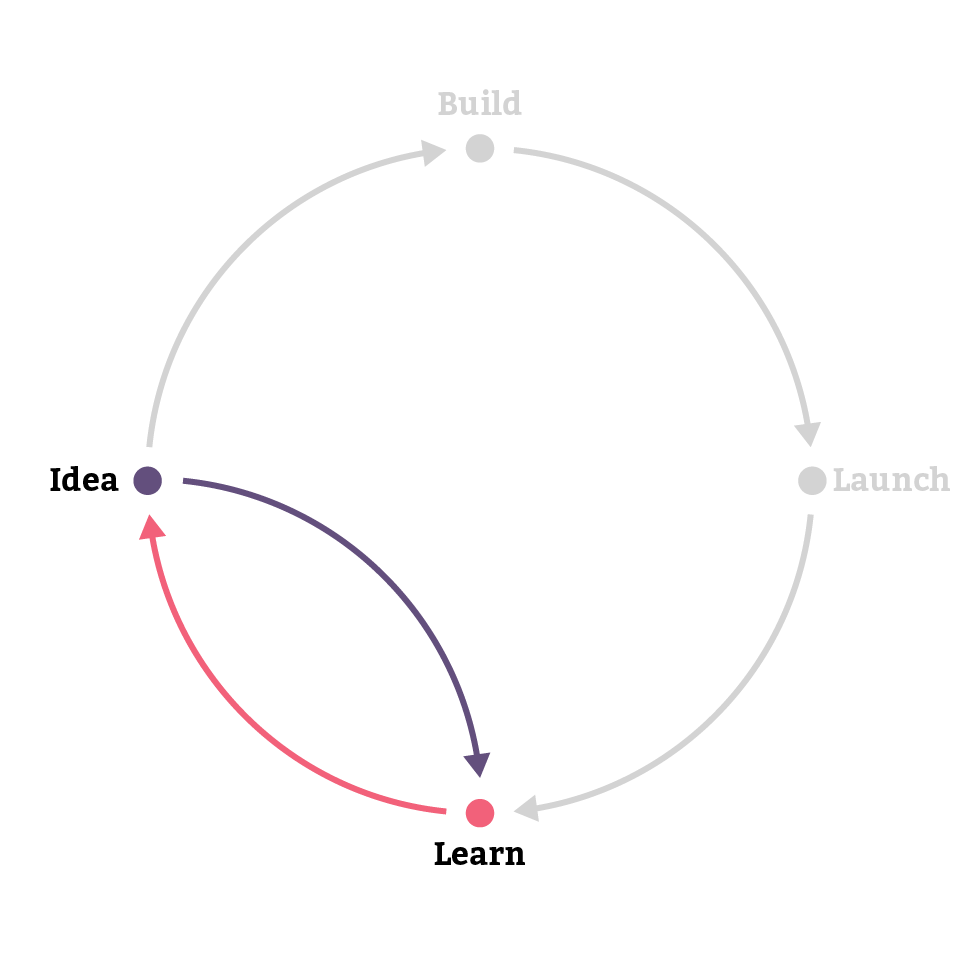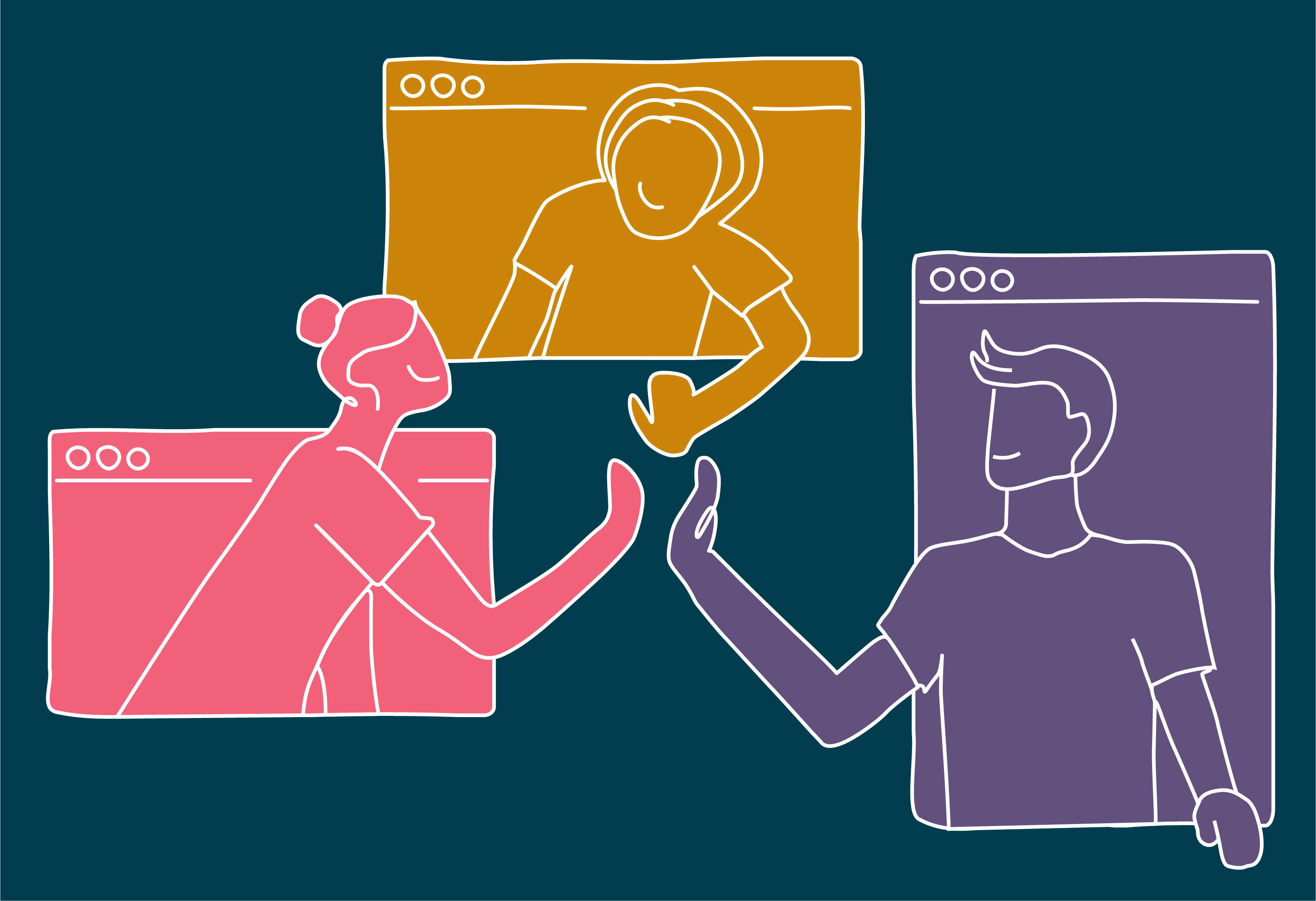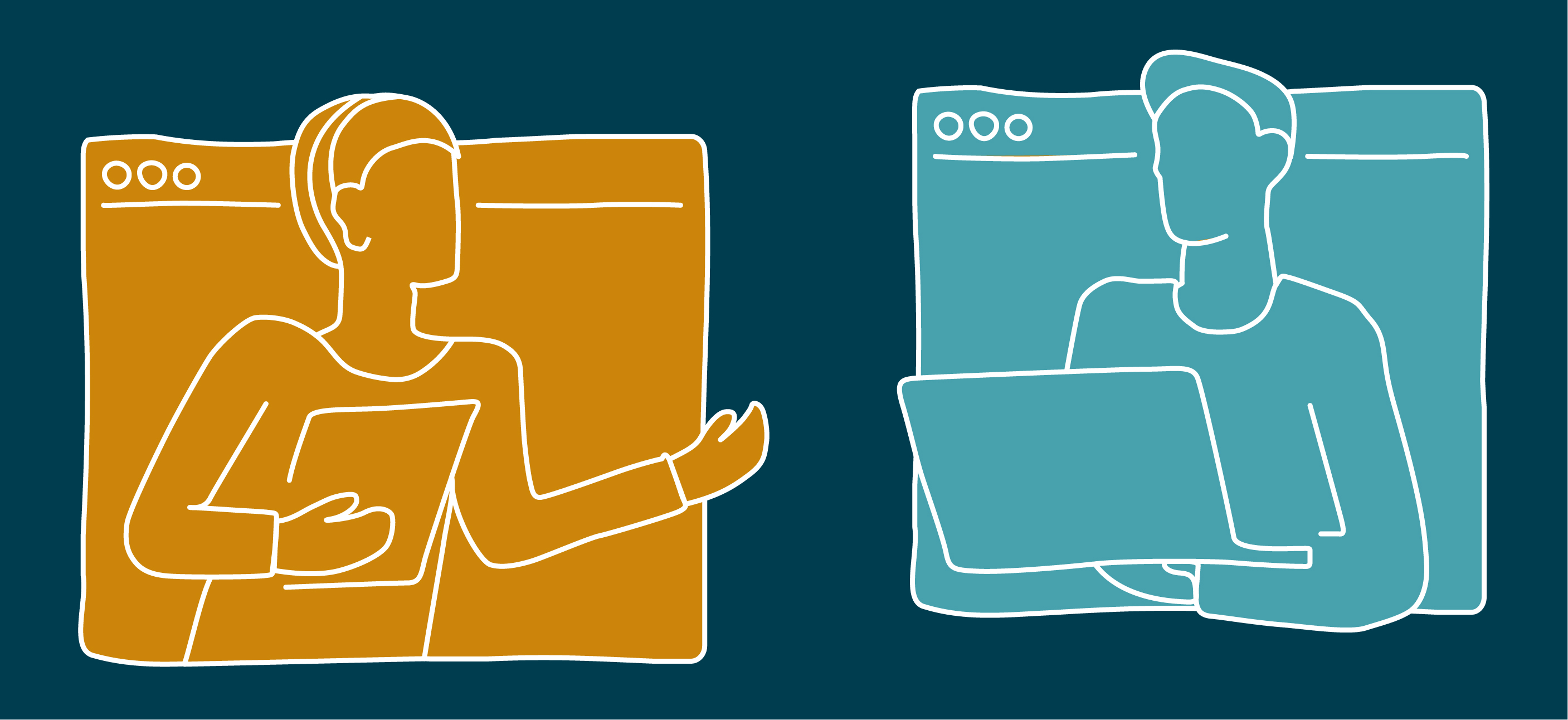When it comes to innovation methods and user-centricity, you cannot avoid Design Sprints. Already at the top in Gartner’s Hype Cycle 2019 [1], it’s quickly making its way further into the standard toolbox of every product team for some excellent reasons. In this article, we briefly touch on what a Design Sprint is and where we see its value. What makes Design Sprints successful in a software delivery culture? And what do you have to keep in mind when conducting them remotely? Continue reading if you are a beginner or intermediate level Design Sprint facilitator. It has insights and inspiration for you. We aim to add to the discourse of advancing the sprint practice here, moving further from innovation theatre to solving real problems and delivering innovative and sustainable outcomes.
What is a Design Sprint again?
Let’s start from the beginning: A Design Sprint (invented by Jake Knapp from Google Ventures) [2] is a time-boxed process that helps us to rapidly gain insights on a (business) problem, ideate solutions, and test them quickly (Illustration I). Thereby, rapidly solving big challenges, creating new products, or improving existing ones. Once the participants are selected, they undergo the five phases within one or two weeks and end up with a tangible prototype, valuable insights and learnings.


Illustration I - The five phases of a Design Sprint
When should I run a Design Sprint?
Before building product features or ideas expensively, you can validate your (riskiest) hypotheses early, learn and create tangible outcomes within a few days (Illustration II). For us, it has been helpful in the following 3 cases:
- we have a pretty good idea about a product (or feature) already and need to sketch out the details rapidly (e.g. before development or as a track in dual-track agile);
- upfront to inform a business case- and/or investment decision; or
- even earlier, when we have an idea but don’t know where to start and you want to get things going quickly.
This is in line with studies such as the Forrester ‘Total Economic Impact Design Thinking’, which states that practices such as Design Sprints can decrease the delivery time of a product by 75%, reducing an 8-month project down to 3-4 months [3]. It cuts the cost of a project by accelerating it and reducing some of the most significant risks right at the start. And while Design Thinking is like learning to cook, a Design Sprint is like a cookbook with recipes and a whole menu. This means product teams have nothing to lose to try it while enjoying some of the most considerable upsides instantly.


A substantial side effect of a Design Sprint is the fun team-building experience and possible mindset shifts, which should both not be underestimated in corporate settings. This is no surprise if you drive a group through a full packed agenda within a few weeks. And that has even another value: as you bring all participating stakeholders to a table and bond them together through the sprint, it aligns them and increases their ownership of the problem and possible solutions.
“We have an existing system that has all the functions on paper, but the Design Sprint helped me to rethink how the look and feel must be that people like to use the system. This was an eye-opening experience. The time and money invested in this was nothing in comparison.” ~Project Manager
Five key-learnings from running (remote) Design Sprints
To fully harvest the benefits of (remote) Design Sprints, we’ll highlight some points and little touches in the following. Nevertheless, there are many excellent guides describing how to run Sprints step-by-step which are an awesome foundation, such as AJ & Smart’s YouTube Channel [3], their playbook [4] or the playbooks from others [5, 6, 7] as well as a large number of templates (for e.g. MIRO [8], MURAL [9], or our templates). Here are the things we found especially helpful in our practice but were missing or short in other Sprints we experienced (or literature we read):
1. Build trust and adjust to the context
It’s about the team and the people—to contextualise and extend the sprint to their needs and situation—over pressing everything into the standard process (Illustration III). To accommodate this, run one-on-one calls and possibly a kick-off workshop. This way, you can take the wider setting and challenges into account.


In our remote settings, we held one-on-one calls with all participants to ensure they trust the process, technology and facilitator. By doing this we were able to resolve concerns and create the groundwork for active participation. In such calls, you can also conduct research on the topic.
While doing essential tech checks a week before the sprint was important, we learned that enabling the group to feel comfortable with the technology was a much bigger lever to improve the Design Sprint. It doesn’t matter which digital whiteboard you use for a Design Sprint; it’s more important to adjust to the group’s tech-savviness level (which can vary in all directions nowadays).
Once we are in the sprint, team building works for us remotely as well as it does in person. We include aspects of team building and daily check-ins and check-outs in the sprint process. We also start with agile retrospectives from the first day. This way, we learn together and adapt to the team and organization. Instead of checking in with individual participants at the coffee machine, we can just send a chat message or set up a quick call in between. Therefore, the activities of the sprint adjust to the needs of the group, and not the other way around. Sometimes, it’s also about scheduling nothing or letting good conversations run over. Still, towards the end of the process, it’s clear that we extensively talk about the next steps, action points, who takes care of them, and make sure that there is clarity about the team’s future ways of working.
The benefits of doing such activities is to support the team building and laying the foundation for the mid-term success of the project.
2. The more perspectives, the better
We include as many perspectives as possible.
On the core team level: Apart from only having facilitators and designers in a sprint, we found that developers are beneficial here as well. Including them helps us to combine all elements smartly and ask the team's right questions to decide, making sure that we come up with desirable, feasible, and viable solutions that are also valuable. For any prototype that needs to be close to an actual product (or using emerging technologies such as VR/MR or blockchain), we found that it is good to add even more developers to (follow-up) sprints and start rapid prototyping.
On a stakeholder level: We include perspectives from different stakeholders by leveraging lightning talks and end-user interview sessions for expert input. Arguably, additional research beforehand helps you, as a facilitator, to understand the nuances of the domain and ask the right questions and create depth to move the group in the right direction.
The benefits we saw here is that we formed better hypotheses, (in)validated the most riskiest hypotheses early on and, again, established ownership across the board.
3. Co-deliver, coach, and grow people
We found value in taking everybody along and making sure that everybody is more capable afterwards. Why are we doing certain things? We explain and share some background, and make our reasoning explicit. How to conduct user testing? We give people a framework, let them watch how we do interviews, encourage them to do user testing themselves, and then give concrete feedback on how they can improve them the next time (Illustration IV). This process feels empowering, especially as you have to do many interviews and directly feel the improvement one interview at a time. And it stays as a skill they use to drive the product development further. Do people wonder how to take the project forward? How to navigate internal organization needs? Be there to support and bring in various perspectives.
Nurturing those aspects we found are often vital to the sustainability and overall success of the project. Once you’re gone again, it’s up to the people to drive it further.


Illustration IV - Make sure you grow and coach participants throughout the sprint. Once it’s over they’ll be even more empowered to drive the project further.
4. Create a healthy mix of time together and sessions offline
The big plus is that remote Design Sprints can adjust to the participants' availability and work across many regions and time zones. However, we found value in breaking sessions down to their initial goals again. Is there another way to reach the goal instead of just running the session online? For example, decision-making can be done synchronously together, whereas researching possible solutions and sketching first ideas work is done individually in the afternoon. This way, the remote sprint version can feature a combination of collaboration sessions together and individual working time, which allows more flexibility in various working styles and schedules. It may stretch the whole Sprint by some days, but it reduces long and exhausting video calls for the participants (and you as facilitators). Finally, we add real breaks (at least 10 minutes for every online hour), individually but also guided with energizers and the like, which we found improves the focus and productivity of the participants during the sessions together, making more then up for the time lost.
On a side note: before the Sprint we sent packages with goodies such as stickies, paper, sharpies, energy bars and individual postcards. Our participants accepted them happily and it made them feel motivated, triggering joyful anticipation and excitement to do the Design Sprint. And while fostering a personal touch despite remote barriers, we found it a good way to ensure that everybody is equipped with the right material for offline or hybrid sessions.
In terms of benefits, here we found out that they are more indirect than the others: we experience less hiccups during the sprint, enabling better learning and a better overall experience. It also helps to make the sprint less exhausting, setting up the foundation for the next point.
5. Use the Sprint as a part to run marathons
Sprints are a great first step; however, keep the big picture in mind and make sure that, if necessary, you keep the momentum going. We do this by planning a second Sprint right after the first Sprint, either to test new hypotheses (it’s good to learn that assumptions have been wrong!) or to create a higher fidelity version of the prototype. Alternatively, a couple of further sessions and planning the next steps (from ways of working over establishing a backlog to introducing dailys), helped us to ensure that the team kept pace and turn the Sprint into full product/feature delivery. Scaling the team with internal or external people (on-site, nearshore or offshore), can be a next step then.
Also, again, we experienced that in many large organisations, the heavy lifting comes after the Sprint. So, be ready to support stakeholder management, more design work, research (into e.g. underlying problems or additional features) and further facilitation.
In terms of process, this goes well together with dual-track agile, in which a research/design-track goes hand-in-hand with the actual development track (Video I), and continues discovery when you are already building a product. At the beginning of a new product, a Lean Inception workshop format might directly follow a Design Sprint. Through all of this, no handover to other people or other ways of working needs to happen, reducing some of the most considerable still existing challenges in modern and agile product development.
Again, here we see the benefits pointing toward sustainability (i.e. establishing a good base for the long run) and reducing the time to market constantly.
How does this look like more concrete? You can read more on our Design Sprint work with innogy and RWE Renewables.
In a Nutshell
A Design Sprint (remote and on-site) is an ideal way to kick off new products, new features or inform a business case- and/or investment decision. You can test ideas early and reduce unnecessary development time and accelerate time to market. The cherry on top: You’ll build a highly motivated team that own the topic equipped with a lean and agile way of working. And—if embedded wisely in a larger context—this can deliver great products and spark cultural changes company-wide. So the next time you’re in the lucky position of facilitating a Design Sprint, make sure you keep these five insights in mind that will improve your Sprint significantly:
- build trust and adjust to the context;
- the more perspectives you add, the better;
- co-deliver, coach, and grow people;
- when done remotely, create a healthy mix of time together and sessions offline; and
- use the Sprint as a part to run marathons.
All there’s left to say is: Think big, start small, and keep it going!
_
Illustrations: Mekong Lam, next to co-authoring the article, and Vlad Harabagiu. A special thanks to Robin W. and Bernd G. for contributing to the first version of the insights, and everybody who reviewed earlier drafts of this article.
Bibliography
[1] Gartner (2019) Hype Cycle for User Experience. Available at: https://www.gartner.com/en/documents/3956040/hype-cycle-for-user-experience-2019 (Accessed: 10 May 2021)
[2] Forrester (February 2018) The Total Economic ImpactTM Of IBM’s Design Thinking Practice. Available at: https://www.ibm.com/downloads/cas/Z4WBDR8Q (Accessed: 10 May 2021).
[3] Jake, K. (no date a) Sprint. Available at: https://jakeknapp.com/sprint (Accessed: 10 May 2021).
[4] AJ&Smart (no date a) AJ&Smart - YouTube. Available at: https://www.youtube.com/channel/UCeB_OpLspKJGiKv1CYkWFFw/search?query=design+sprint (Accessed: 10 May 2021).
[5] AJ&Smart (no date b) The Ultimate Guide to Remote Designs Sprint by AJ&Smart. Available at: https://ajsmart.clickfunnels.com/optin-376785761585903169686 (Accessed: 10 May 2021).
[6] New Haircut (no date) Design Thinking Toolkits | Templates, New Haircut. Available at: https://www.newhaircut.com/design-thinking-toolkits (Accessed: 10 May 2021).
[7] Jake, K. (no date b) The Remote Design Sprint Guide, The Design Sprint. Available at: https://www.thesprintbook.com/remote (Accessed: 10 May 2021).
[8] MURAL (no date b) The Definitive Guide To Facilitating Remote Workshops | MURAL. Available at: https://www.mural.co/ebook (Accessed: 10 May 2021).
[9] MIRO (no date) Remote Design Sprint Template | Run a Design Sprint Remotely | Miro, https://miro.com/. Available at: https://miro.com/templates/remote-design-sprint/ (Accessed: 10 May 2021).
[10] MURAL (no date a) Design Sprint. Available at: https://www.mural.co/templates/design-sprint (Accessed: 10 May 2021).
[11] Adriana Katrandzhieva (October 15th 2020) Dual-Track Agile for Discovery & Development. Available at: https://www.youtube.com/watch?v=Dr9fqI6BKdY (Accessed: 10 May 2021).
[12] Paulo Caroli (05 April 2017) Lean Inception. Available at: https://martinfowler.com/articles/lean-inception/ (Accessed: 10 May 2021)















